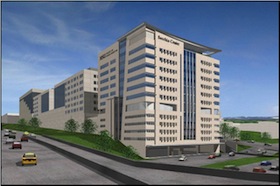Michigan State Human Medicine Earns LEED Gold
 GRAND RAPIDS — The headquarters for the College of Human Medicine at Michigan State University recently earned LEED Gold certification, the second one on the campus.
GRAND RAPIDS — The headquarters for the College of Human Medicine at Michigan State University recently earned LEED Gold certification, the second one on the campus.The Secchia Center, a 180,000-square-foot project that opened last fall in downtown Grand Rapids, features energy-efficient lighting, heating and cooling systems, and building materials within 500 miles in addition to other sustainability measures expected to save $234,000 per year.
The heating system includes radiant floor heat in the center’s atrium and a heat wheel that captures and recycles heat otherwise wasted. Lecture halls are equipped with monitors to detect elevated carbon dioxide level sand automatically adjust ventilation to bring in the proper amount of fresh air, according to school officials.
In addition to adhesives, paint, and carpeting with low levels of volatile organic compounds; restroom fixtures designed to minimize water usage; and stored rainwater tanks to use as a cooling tower to reduce city water usage, the center’s urban location also enables the use of public transportation and existing water and sewer lines.
“While those sustainable features somewhat increased construction cost, the resulting energy savings will offset it in a little more than six years,” said Shirine Boulos Anderson, principal with Ellenzweig, design architect for the new headquarters.
School officials said the center was able to earn LEED Gold amidst “tremendous financial pressures.”
“This building demonstrates that one can build sustainably without sacrificing quality, aesthetics or function — and we can do it all for an affordable price,” said Daniel Bollman, design administrator with the university’s Physical Plant Engineering Planning department.
Officials said earning the certification required a great deal of commitment from all parties and a rigid management process.
“For example, it’s one thing to plan on recycling most waste materials, but it’s another to make sure it happens,” said Dan LaMore, senior vice president of the Christman Co., which managed the building’s construction.
Environmental stewardship applied at every step of the Secchia Center’s design and construction, according to Elizabeth Lawrence, assistant dean for capital and strategic planning at the College of Human Medicine.
The Secchia Center is financed entirely without public funding, with sources including $55 million in committed funding from Spectrum Health and private donations.
“It’s important to note that if you walked into the building, you’d notice how comfortable it is. It’s not as if it will scream ‘sustainability’ at you,” said Dick Temple, principal in charge of URS Corporation’s Michigan higher education practice. “The important takeaway is it won’t look dated. It will stand the test of time.”
